let's_talk_2_unit8
- 格式:doc
- 大小:100.00 KB
- 文档页数:7
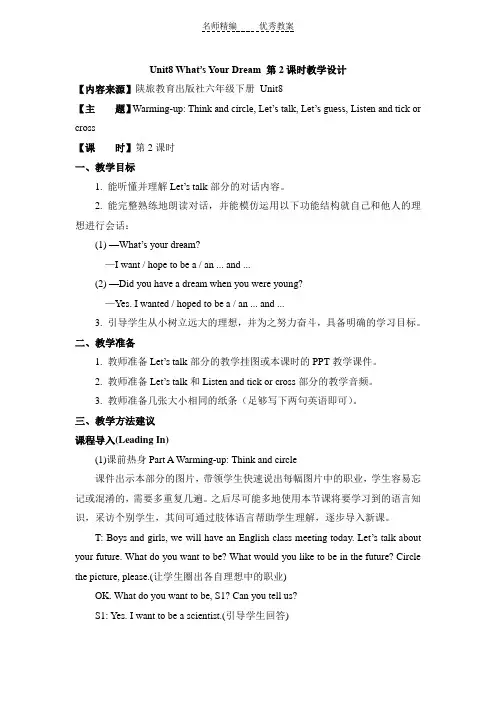
Unit8 What’s Your Dream第2课时教学设计【内容来源】陕旅教育出版社六年级下册Unit8【主题】Warming-up: Think and circle, Let’s talk, Let’s guess, Listen and tick or cross【课时】第2课时一、教学目标1. 能听懂并理解Let’s talk部分的对话内容。
2. 能完整熟练地朗读对话,并能模仿运用以下功能结构就自己和他人的理想进行会话:(1) —What’s your drea m?—I want / hope to be a / an ... and ...(2) —Did you have a dream when you were young?—Yes. I wanted / hoped to be a / an ... and ...3. 引导学生从小树立远大的理想,并为之努力奋斗,具备明确的学习目标。
二、教学准备1. 教师准备Let’s talk部分的教学挂图或本课时的PPT教学课件。
2. 教师准备Let’s talk和Listen and tick or cross部分的教学音频。
3. 教师准备几张大小相同的纸条(足够写下两句英语即可)。
三、教学方法建议课程导入(Leading In)(1)课前热身Part A Warming-up: Think and circle课件出示本部分的图片,带领学生快速说出每幅图片中的职业,学生容易忘记或混淆的,需要多重复几遍。
之后尽可能多地使用本节课将要学习到的语言知识,采访个别学生,其间可通过肢体语言帮助学生理解,逐步导入新课。
T: Boys and girls, we will have an English class meeting today. Let’s talk about your future. What do you want to be? What would you like to be in the future? Circle the picture, please.(让学生圈出各自理想中的职业)OK. What do you want to be, S1? Can you tell us?S1: Yes. I want to be a scientist.(引导学生回答)T: Sounds great.(竖起大拇指夸学生) Would you like to be a scientist and study the stars?S1: Yes. I would like to be a scientist. / I would like to study the stars.T: What would you like to be, S2?S2:I would like to be ...结合学生对语言知识的运用情况与学生进行自由地交流,也可以帮助学生回答,引导学生尽量回答完整,并尽可能多地重复would you like ...和课文中将要出现的语句,加深学生的理解。
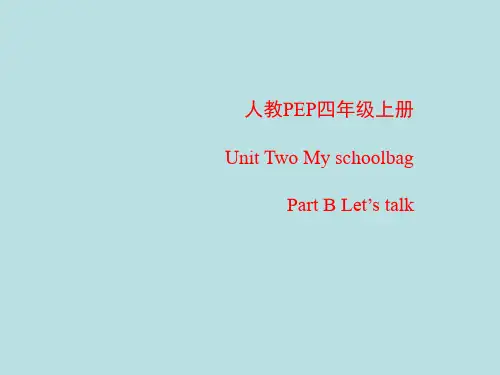
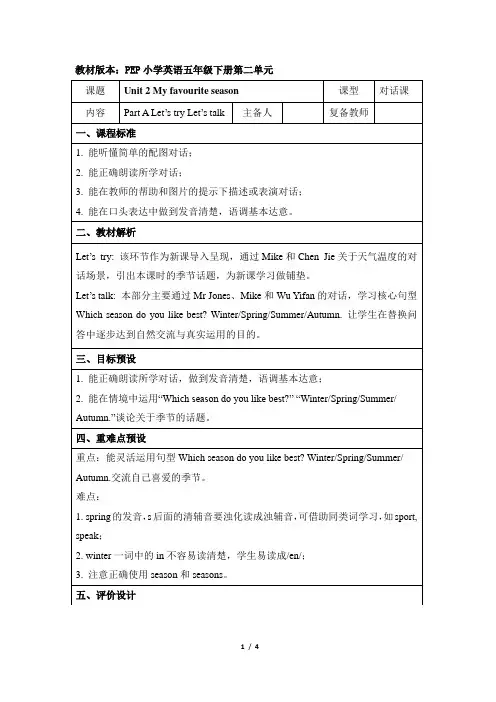
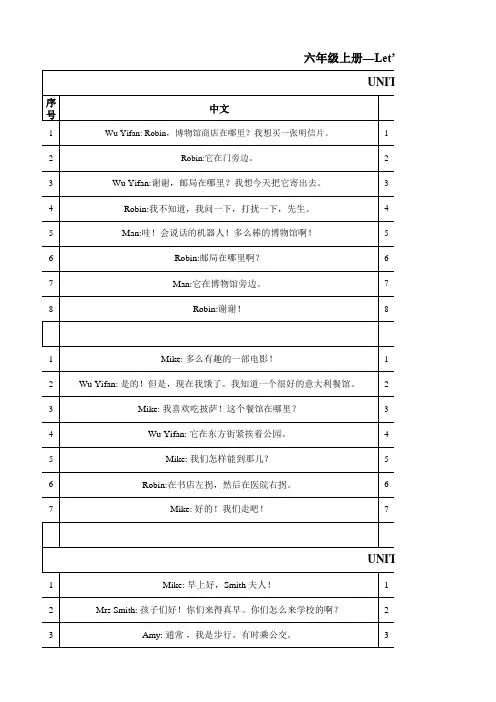
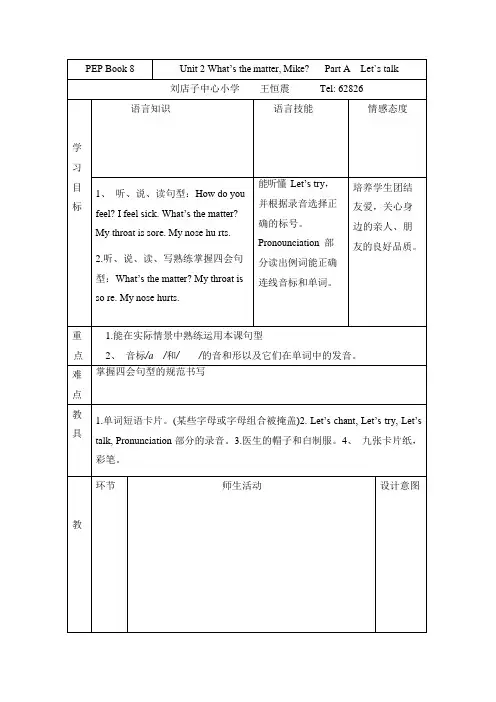
1.能在实际情景中熟练运用本课句型2、音标/a/和//的音和形以及它们在单词中的发音。
己的相应部位回答:I have a sore throat. My throat is sore and my nose hurts.并板书句子。
(2) W hat’s the matter with Amy?播放Let’s talk 部分录音,学生跟读。
(3) 学生分组朗读对话。
(4) Act and practice1.学生根据Let’s try 的图表演新的对话,并提供句型结构,学生两人一组编对话,一人演病人,一人演医生:A: How do you feel?B: I feel sick.A: What’s the matter?B: I have …. My … is sore. / My … hurts.2.找几组学生为大家表演,教师为扮演医生的同学提供白帽子和医生制服。
Pronunciation(1) 教师呈现单词:home, note, rose, yellow, know, slow, coat, load, soap,请学生朗读,并启发学生说出它们中的共同音素//;教师板书音标,学生认读;启发学生说出在单词中发//的字母或字母组合:o, o w, oa。
(2) 教师呈现单词:count, about, house, cow, brown, now,请学生朗读,并启发学生说出它们中的共同因素/au/;教师板书音标,学生认读;启发学生说出在单词中发/au/字母组合:ou, ow。
(3)让学生观察/a/和//在发音和外形上的区别,请个别学生总结。
(4) 播放Pronunciation 部分的录音,学生指词跟读。
(5) 教师提示音标/k/ , /n/ , /h/ , /l/ , /s/ , /r/的音和形,请学生完成Read and match 部分练习。
1. Bingo game(1) 出示单词:headache,toothache,学生朗读;再出示单词:earache,stomachache,请学生观察规律试着拼读,并说出单词的意思;如果学生读不对,教师要示范。
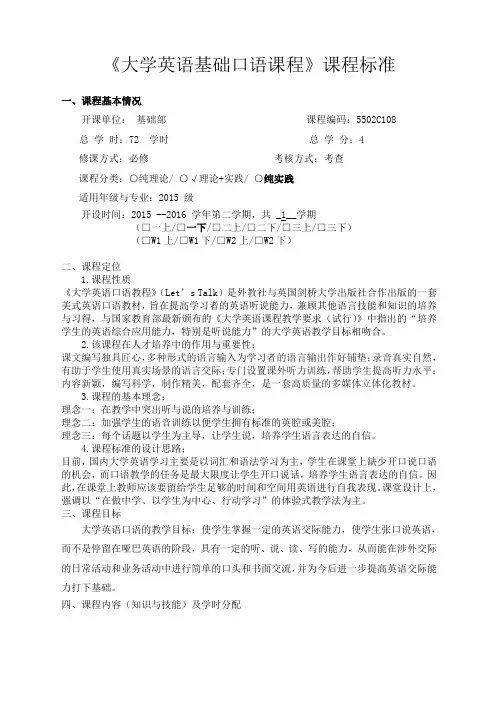
《大学英语基础口语课程》课程标准一、课程基本情况开课单位:基础部课程编码:5502C108总学时:72 学时总学分:4修课方式:必修考核方式:考查课程分类:○纯理论/ ○√理论+实践/ ○纯实践适用年级与专业:2015 级开设时间:2015 --2016 学年第二学期,共 _1__学期(□一上/□一下/□二上/□二下/□三上/□三下)(□W1上/□W1下/□W2上/□W2下)二、课程定位1.课程性质《大学英语口语教程》(Let’s Talk)是外教社与英国剑桥大学出版社合作出版的一套美式英语口语教材,旨在提高学习者的英语听说能力,兼顾其他语言技能和知识的培养与习得,与国家教育部最新颁布的《大学英语课程教学要求(试行)》中指出的“培养学生的英语综合应用能力,特别是听说能力”的大学英语教学目标相吻合。
2.该课程在人才培养中的作用与重要性;课文编写独具匠心,多种形式的语言输入为学习者的语言输出作好铺垫;录音真实自然,有助于学生使用真实场景的语言交际;专门设置课外听力训练,帮助学生提高听力水平;内容新颖,编写科学,制作精美,配套齐全,是一套高质量的多媒体立体化教材。
3.课程的基本理念;理念一:在教学中突出听与说的培养与训练;理念二:加强学生的语音训练以便学生拥有标准的英腔或美腔;理念三:每个话题以学生为主导,让学生说,培养学生语言表达的自信。
4.课程标准的设计思路;目前,国内大学英语学习主要是以词汇和语法学习为主,学生在课堂上缺少开口说口语的机会,而口语教学的任务是最大限度让学生开口说话,培养学生语言表达的自信。
因此,在课堂上教师应该要留给学生足够的时间和空间用英语进行自我表现。
课堂设计上,强调以“在做中学、以学生为中心、行动学习”的体验式教学法为主。
三、课程目标大学英语口语的教学目标:使学生掌握一定的英语交际能力,使学生张口说英语,而不是停留在哑巴英语的阶段,具有一定的听、说、读、写的能力,从而能在涉外交际的日常活动和业务活动中进行简单的口头和书面交流,并为今后进一步提高英语交际能力打下基础。
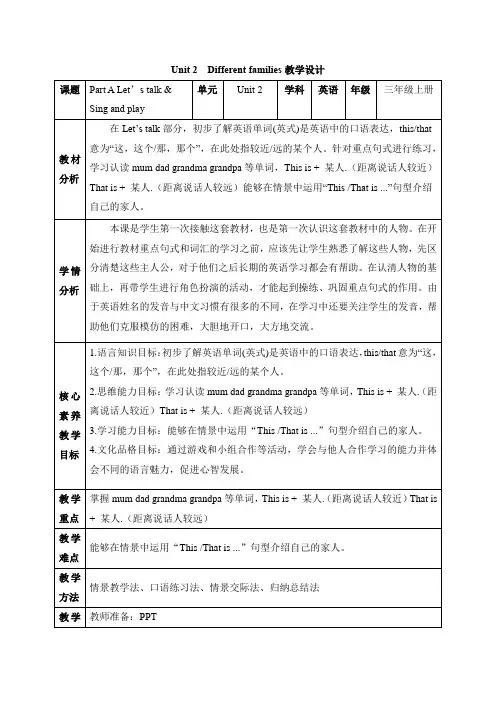
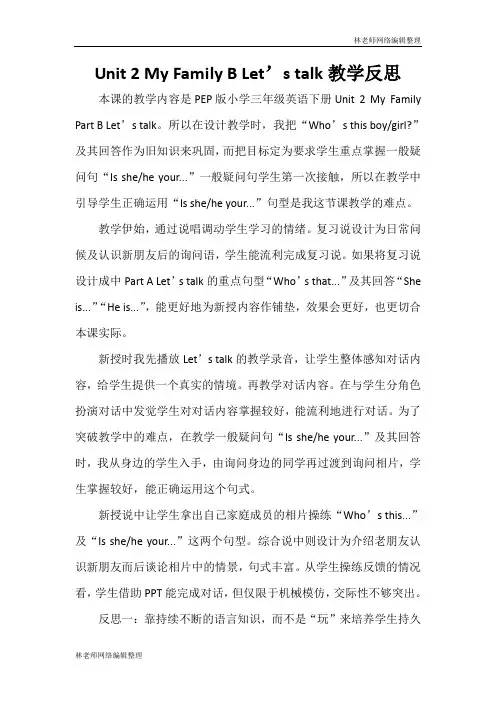
Unit 2 My Family B Let’s talk教学反思本课的教学内容是PEP版小学三年级英语下册Unit 2 My Family Part B Let’s talk。
所以在设计教学时,我把“Who’s this boy/girl?”及其回答作为旧知识来巩固,而把目标定为要求学生重点掌握一般疑问句“Is she/he your...”一般疑问句学生第一次接触,所以在教学中引导学生正确运用“Is she/he your...”句型是我这节课教学的难点。
教学伊始,通过说唱调动学生学习的情绪。
复习说设计为日常问候及认识新朋友后的询问语,学生能流利完成复习说。
如果将复习说设计成中Part A Let’s talk的重点句型“Who’s that...”及其回答“She is...”“He is...”,能更好地为新授内容作铺垫,效果会更好,也更切合本课实际。
新授时我先播放Let’s talk的教学录音,让学生整体感知对话内容,给学生提供一个真实的情境。
再教学对话内容。
在与学生分角色扮演对话中发觉学生对对话内容掌握较好,能流利地进行对话。
为了突破教学中的难点,在教学一般疑问句“Is she/he your...”及其回答时,我从身边的学生入手,由询问身边的同学再过渡到询问相片,学生掌握较好,能正确运用这个句式。
新授说中让学生拿出自己家庭成员的相片操练“Who’s this...”及“Is she/he your...”这两个句型。
综合说中则设计为介绍老朋友认识新朋友而后谈论相片中的情景,句式丰富。
从学生操练反馈的情况看,学生借助PPT能完成对话,但仅限于机械模仿,交际性不够突出。
反思一:靠持续不断的语言知识,而不是“玩”来培养学生持久的兴趣。
小学英语教学要重视培养兴趣,但单靠唱歌、游戏不能培养学生持久的兴趣。
新鲜劲儿一过,孩子们就会厌倦。
所以,唱歌游戏应该作为学生学习英语语言知识、技能的部分手段,而不是培养兴趣的唯一手段。
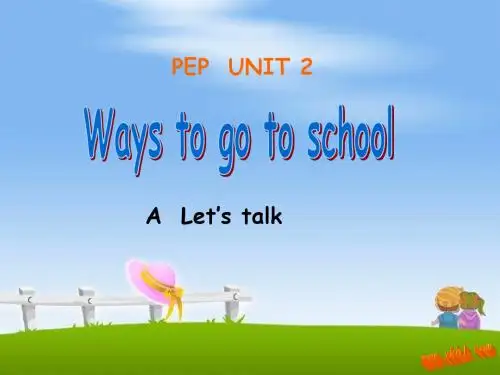
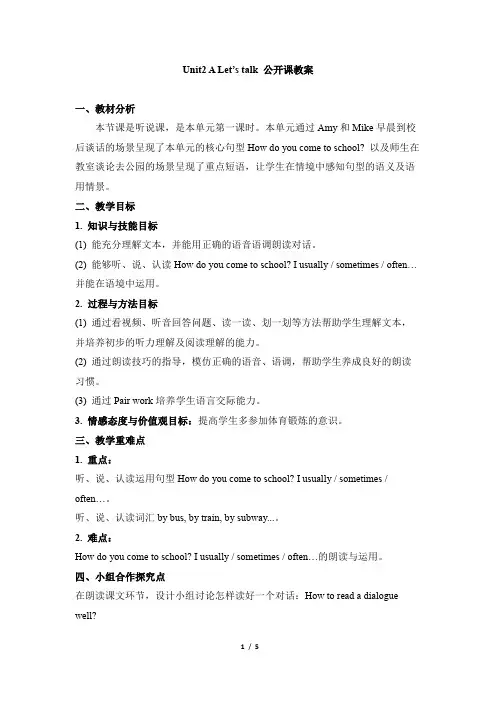
Unit2 A Let’s talk 公开课教案一、教材分析本节课是听说课,是本单元第一课时。
本单元通过Amy和Mike早晨到校后谈话的场景呈现了本单元的核心句型How do you come to school? 以及师生在教室谈论去公园的场景呈现了重点短语,让学生在情境中感知句型的语义及语用情景。
二、教学目标1. 知识与技能目标(1) 能充分理解文本,并能用正确的语音语调朗读对话。
(2) 能够听、说、认读How do you come to school? I usually / sometimes / often…并能在语境中运用。
2. 过程与方法目标(1) 通过看视频、听音回答问题、读一读、划一划等方法帮助学生理解文本,并培养初步的听力理解及阅读理解的能力。
(2) 通过朗读技巧的指导,模仿正确的语音、语调,帮助学生养成良好的朗读习惯。
(3) 通过Pair work培养学生语言交际能力。
3. 情感态度与价值观目标:提高学生多参加体育锻炼的意识。
三、教学重难点1. 重点:听、说、认读运用句型How do you come to school? I usually / sometimes / often…。
听、说、认读词汇by bus, by train, by subway...。
2. 难点:How do you come to school? I usually / sometimes / often…的朗读与运用。
四、小组合作探究点在朗读课文环节,设计小组讨论怎样读好一个对话:How to read a dialogue well?五、教学资源:PPT六、教学过程Step 1 Warm up1. GreetingsT: Good morning, boys and girls. Today we will learn Unit 2 Part A Let’s talk.2. Let’s chantT: First let’s have a chant.(设计意图:活跃课堂气氛,让学生初步感知本节课的主要句型及词汇。
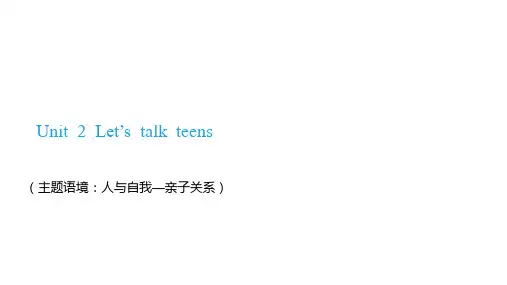
人教PEP版英语六年级上册Unit-2-B-Let’’s-talk教案教案一. 教材分析人教PEP版英语六年级上册Unit 2的主题是“My family and friends”,主要让学生学习描述家庭成员和朋友的基本词汇。
本课B部分“Let’s talk”主要通过一个简单的对话,让学生掌握并运用本课的核心词汇和句型。
对话内容主要是介绍家庭成员,并询问对方的家庭成员。
二. 学情分析六年级的学生已经具备了一定的英语基础,对于描述家庭成员和朋友的认识也比较清晰。
但是,部分学生可能在听说方面还存在一定的困难,需要教师的耐心引导和反复练习。
此外,学生对于家庭和朋友的情感认同较强,对于本课的内容会有较高的兴趣。
三. 教学目标1.学生能够听懂、会说、会读本课的核心词汇和句型。
2.学生能够在真实情境中运用所学知识进行简单的交流。
3.学生能够通过本课的学习,增强对家庭和朋友的情感认同。
四. 教学重难点1.重点:学生能够听懂、会说、会读本课的核心词汇和句型。
2.难点:学生能够在真实情境中灵活运用所学知识进行交流。
五. 教学方法采用情境教学法、任务型教学法和分组合作学习法。
通过设定真实的情境,让学生在完成任务的过程中,自然地学习和运用所学知识。
同时,分组合作学习法能够激发学生的学习兴趣,提高学生的参与度。
六. 教学准备1.教师准备本课的教学课件和教学资源。
2.学生准备课本和笔记本。
七. 教学过程1.导入(5分钟)教师通过提问方式引导学生回顾上一课的内容,如“What did you learn about last time?”,然后引入本课的主题“My family and friends”。
2.呈现(5分钟)教师通过课件展示本课的核心词汇和句型,如“This is my mother.”、“This ismy friend.”等,并用图片或实物进行辅助呈现,帮助学生理解和记忆。
3.操练(10分钟)教师学生进行分组练习,每组学生模拟对话,运用所学词汇和句型进行交流。
Unit 8 Travel and Transportationby 贾丽萍Objectives:1.To be able to talk about different kinds of vocations;2.To be able to talk about various forms of transportation;3.To describe the features of different vacation and transportation by comparison;4.To use t he sentence patterns to state out one’s own ideas according to the topic.Focuses:1.To be familiar with the words and phrases related to travel and transportation;2.To improve listening and speaking ability.Procedures:First ClassPart 1Warm-up (5 mins)Do the QUIZ (reference material ) to check what Ss know about travel and transportation and get familiar with the words and phrases.It’s not necessary to do the whole, Teacher can choose some from the QUIZ.Part2: 8A: Going placesActivity 1 (25 mins)Step 1. Lead-in (5 mins)Think about the following question (whole class):What you did on your last vocation? / How do you spend your summer vocation?There are several ways to spend the holiday. For example, staying at home alone or with family; going out with some friends; have a package tour to some attractive places; visiting some relatives in the countryside or showing your friends around to some local places, etc.Vocabulary:adventurehikingbackpackingfishingcampingmountain climbing sightseeingwildlifescenery旅行社travel service/agency 假日旅行vacation tour 目的地destination自然景观natural scenery/attraction人文景观places of historic figures andcultural heritage名山大川famous mountains and great rivers 名胜古迹scenic spots and historical sites度假胜地holiday resort自然保护区nature reserve国家公园national park旅游景点tourist attraction古建筑群ancient architectural complexStep 2. Pair work (look at the pictures and discuss) (5mins)1). What people did on their vacations?hiking, visiting the museum, staying at home, picking apples in the farm 2). Which vacations look like fun? Which don’t?Step 3. Listening to the description of their vacations and fill in the chart (15 mins)First time: global listen and write the number of the description on the correct picture;Second time: pausing after each speaker for students to mark their answers in the chart;Third time: check the answersVocabulary:To be in season: to be available fresh locally at that time.To end up: to achieve that situation after other activitiesTo show around: to lead through a placeY ucky: unpleasant(slang)To convince: to cause someone to do somethingGear: equipmentTo scare to death: to frighten a lotSoaking wet: completely wetIn the middle of nowhere: far away from people and cities.To cover: to travelAppalachian Trail: a mountainous hiking route in the eastern United StatesStep 4. Pair work (optional)Now that you know more about the people did on their vacations, which of the four vacations was the most appealing and why?Activity 2 (25 mins)Step 1. Group work (group of 4, discussion) (8 mins)What are the people doing? Where do you think they are?hammock 吊床, sand, sea, surf, sunshine, picnic, golf, beach, mountain, golf course, Effie Tower Imagine that you can take one of these vacations, which should you choose? Why?Step 2. Communication task (pair work) (5 mins)Student A: task 8: p 76 (choose one picture)(fishing, mountain climbing, renting motorcycle)look at the picture and describe what you think happened next to your partner.Student B: task23: p 82 (diving, taking photos, painting a portrait)the same as SA(remind students use storytelling techniques, saying where, when, and in what order thing happened)Setting homework (2 mins)1. Complete the previous task.2. Describe one of your unforgettable journey/trip.Sample:Last year, I went to ____ with ____. ____is located ____. It took us ____ to get ____. ____is famous for ____. (description of the place). In addition, I ____. I think that is an interesting trip.Second Class (continued)Step 1. Presentation (5 mins)Ask some students to present their homework.Step 2. Group work (7 mins)Discuss what the vacations had in common.Be unaware of and neglect the potential danger (/ )keep an eye on your credit cardsbeware of pickpocketsbeware of dangerous surf that may sweep you out to the seatourist injured while drivingstay off the railingphoto session turns deadlyStep 3. Questions for further discussion (optional) (5 mins)Teacher can choose some for discussion1) Describe some interesting things happened during your travel. Can you describe it for me?2) What is your goal to travel and your reason to travel isI enjoy traveling. It is so interesting to see how other people live, and it is really an amazing way to learn about different cultures.3) Describe the advantage and disadvantage of travel for the countryTourism is a useful source of foreign currency for the country, but sometimes visitors destroy cultural heritage.4) Why China can attract people to travel?A 5,000--year cultural heritage attract more people to China.5) Do Chinese like to travel? Why?I think Chinese people like to travel, but about 20 years ago, Chinese people have little money. With the open policy more and more Chinese people like to travel, because they have more time and money for travel.6) What holiday do Chinese like to tour, and where?Generally speaking, Chinese people like to travel in the national days the spring festival, and international labor day, because in these holidays, we have a long holidays about 7 days. Most people make use of these holidays to travel sceneries such as famous mountains, museums, and galleries.7) Compare the difference about traveling among Chinese people between 100 years ago and now?100 years ago, transportation was very difficult; few people could travel in China because most of people were very poor. But now, transportation is easy and convenient and we have ample money for the journey.8) What should you pay attention to in travel?Safety, weather, and I think it is necessary to bring some medicinePart 3: 8B: On the roadActivity 1:Step 1: lead-in (5 mins)Look at the pictures and discuss: What would you do in each situation?Brainstorming with the things that can go wrong when you’re driving in a car, such as brake failure, run out of gasoline, flat tire, engine is out of work, break down on the side of the road, accident, break traffic laws, pulled over by the police.Step 2: Pair work (15 mins)1. Look at the pictures and discuss: What would you do in each situation?ask for help, repair the car by oneselfVocabulary:To break down: to stop working (mechanical things)To get a ticket: to receive an official piece of paper that tells someone that they have broken traffic law2. Look at the chat and discus the questions:1) In which country do people travel the most by car? By air? In which country do people travel the least by these forms of transportation?The most by car in the US, train in Japan, air in the US, the least by car in South Korea, train in the US, air in Brazil.2) What do you think are the reasons for the differences?economy, landscape, living standard3) What forms of transportation do you use? Where do you take them?By car, train, air, bus, bike, on foot4) Compare the different transportation, such as between plane, train, car.Generally speaking, planes are the safest traffic transportation. It is very fast, but the flight tickets are very expensive in China. If you have a long distance trip more than 800 kilometers ,we should take planes . Trains are much cheaper than planes. If your destination is located near the train station and within 300 kilometers, you should take trains. They are more comfortable than planes. But the most convenient tool is car, you can travel anytime and to anywhere you like.5) Just compare the transportation in the past and now. Y ou like what transportation and why?In China, long time ago, people used horse, cows, on foot. Then it has changed into bikes trains, now we can travel by plane, train, bus, car, motorcycle. I personally like motorcycles, because they are very convenient.Step3: Join another group (4 persons) and discuss (7 mins)Who has the easiest trip from your home to our college? The most difficult?Who takes more than one forms of transportation?Setting homework (1 min)Give me some opinion on the transportation in your city.Reference:In Chengdu, the public transportations are mainly buses and bicycles. The chief mode of transportation in Chengdu for its people is the bicycle. Given the flat terrain of Chengdu, transportation in Chengdu by bikes is easy and quicker. Bikes are very popular and convenient. The other common modes of transportation in Chengdu consist of taxis, buses, pedicabs. In the city, a single bus ride, whatever be the length of distance costs 1¥or 2¥. And more and more people have private cars.Chengdu has one airport, the Chengdu Shuangliu International Airport (CTU), in the southwest of Chengdu City. CTU offers flights to more than 70 domestic cities and international flights include service to over 20 cities.As the largest railway hub in southwest China, Chengdu Railway Station has trains to major cities. Chengdu has several main coach stations.Third ClassActivity 2:Step 1: lead-in (5 mins)Invite 1 or 2 students present the homework set in last periodStep 2: Pair work (5 mins):Discuss in pairs the following question:What’s the best way to get to these places? (from college, your home)The nearest airport, bank, park, hotel, stadium, department store…Many traffic lines linking the suburb of the city to the downtown areas so residents of enjoy abundant choices of convenient means of traffic to and from the city center.a four ring road system, metro lines(under-construction)Step3: Group (4 persons) discussion (15 mins)Vocabulary:Family sedan 家庭轿车Sports-utility- vehicle (SUV) 运动型多用途车Small Recreation V ehicle (SRV) 休闲车Multi-Purpose V ehicle (MPV) 多用途车Spots car 跑车Classic and antique car 经典古董车Limousine 豪华轿车Jeep 吉普车Look at the photos and discuss the questions below:1. Do you think a car says something about the driver? What kind of person typically drives each of the cars above?Traditional, rich and powerful, aggressive, adventurous, young, , traveler, cool, energetic.2. What kinds of cars are the most popular in your country?Car brands:Audi, BMW, Cadillac, Ferrari, Ford, Honda, Mercedes-Benz, Mitsubishi, Nissan, Rolls Royce, SaabSuzuki, Toyota, V olkswagen, V olvo…3. Which car above would you like to have? / What kind of car do you prefer? Why?Step4: Listening practice (20 mins)Student’ book page 99Part A: track 20Part B: track 21Part C: track 22Reference://special/detail.jsp?id=87876&ClassID=020*******QUIZHoliday 度假1 When you arrive at the airport, the first thing you do is go to ________.A. ReceptionB. the check-in deskC. the departure loungeD. the arrival desk“reception"一般都设在饭店或办公楼里,你检票后才能进入“the departure lounge”, 你到“the check-in desk”验票。